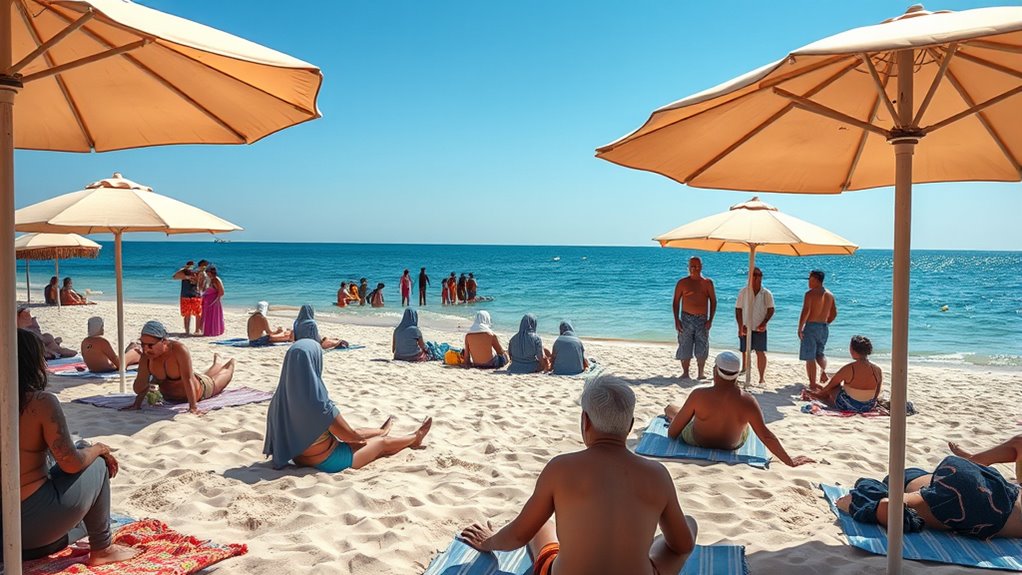Tanning etiquette varies greatly across cultures. In Western societies, tanning often symbolizes health, leisure, and attractiveness, encouraging moderation, while in many Eastern regions, lighter skin is prized as a sign of status, leading to discouragement of sun exposure. Gender roles influence practices too—women often seek tans for beauty, whereas some cultures associate tanning with lower social status. To understand these diverse perspectives and what influences behavior, explore more about how traditions and social norms shape tanning customs worldwide.
Key Takeaways
- Cultural perceptions of tanning vary: Western societies often associate it with leisure and attractiveness, while some Eastern cultures value lighter skin as a status symbol.
- Indoor and outdoor tanning practices are regulated differently across regions, with some countries imposing restrictions and safety warnings.
- Tanning etiquette influences behavior, such as modesty in public tanning in regions valuing lighter skin and relaxed norms in Western beach cultures.
- Gender roles affect tanning norms, with women more likely to engage in indoor tanning for beauty standards, whereas men’s tanning behaviors are often situational.
- Media and cultural beauty ideals shape tanning practices worldwide, promoting bronzed looks in some regions and light skin preferences in others.
Western Perspectives on Tanning and Social Norms

Western perspectives on tanning and social norms have shifted considerably over the past century. In the early 20th century, a tan symbolized luxury and leisure, especially among the upper class in North America and Europe. Before that, a tan was linked to outdoor work and lower social status. The rise of beach culture and sun vacations popularized tanning as an attractive, healthy look. However, by the late 20th century, health concerns about sun damage and skin cancer caused a reevaluation. Fair skin regained its association with sophistication and refinement. Today, many recognize the risks of UV exposure, leading to a preference for sunless tanning or embracing natural skin tones. Despite health warnings, tanning remains a social norm driven by perceptions of attractiveness, confidence, and social acceptance. Additionally, the cultural significance of skin color continues to influence individual choices regarding tanning across different societies, with some cultures valuing lighter skin as a sign of social status and others embracing darker tones as a symbol of vitality. The shifting attitudes toward tanning are also influenced by beauty standards, which are shaped by media portrayals and societal expectations, reflecting broader shifts in health awareness in Western societies. Interestingly, modern innovations like self-tanning products have made it easier for individuals to achieve a bronzed look without UV exposure, reflecting a growing emphasis on health-conscious beauty practices.
Eastern Attitudes Toward Skin Color and Tanning Practices

In many East Asian cultures, light skin has long been a symbol of wealth, status, and beauty, reflecting historical social divisions that favored those who avoided outdoor labor. This preference predates European influence and traces back to dynastic eras when fair skin signified privilege. In South Asia, lighter skin is also associated with beauty and social advantage. While traditional views emphasize pale skin, modern China shows a shift, with some embracing a lightly tanned or bronze look as a sign of health and independence. Media reinforce these ideals by promoting skin-lightening products and whitening salons, especially in urban centers. However, Japanese society holds complex views, often associating skin color with refinement or imperfections, leading to ongoing discrimination and a nuanced attitude toward tanning and skin tone. Recognizing cultural perceptions of skin tone helps to understand the varied attitudes toward tanning practices across these regions. Additionally, social perceptions of beauty continue to evolve, influencing individual choices regarding skin care and tanning.
Regional Variations in Tanning Etiquette and Public Behavior

Regional attitudes toward tanning and public behavior vary widely, shaped by cultural values, legal regulations, and social norms. In many countries, laws regulate indoor tanning, requiring health warnings and sometimes banning advertising, especially to protect vulnerable groups. These regulations aim to inform rather than restrict, with differences across regions. In Western countries like North America and Europe, tanning has historically symbolized health, wealth, and leisure, with social norms encouraging moderation at beaches and outdoor venues. Conversely, regions where lighter skin signifies social status may discourage sun exposure or public tanning altogether. Cultural perceptions influence behavior—some areas view tanning negatively due to associations with outdoor labor or lower socioeconomic standing. Additionally, water-based leisure activities such as swimming and sunbathing at water parks often come with their own set of etiquette standards to ensure safety and enjoyment for all participants. Respecting local etiquette—such as punctuality, hygiene, and communal rules—remains essential for a positive tanning experience. Understanding local cultural attitudes toward sun exposure can help visitors navigate different social expectations more effectively. Moreover, awareness of public health guidelines related to sun safety can further enhance respectful and responsible behavior in various regions, especially given the importance of personality traits like conscientiousness in adhering to safety norms. Recognizing cultural diversity in tanning practices can also promote more inclusive and culturally sensitive interactions among diverse populations.
Gender Roles and Expectations in Tanning Habits

Gender plays a significant role in shaping tanning habits and the social expectations surrounding them. Women are much more likely to use indoor tanning, especially in the 18-24 age group, driven by beauty standards and social attractiveness. They often associate tanning with desirability, influenced by cultural norms and peer competition. Women tend to seek professional, clean environments and are more aware of skin cancer risks, yet still tan for appearance reasons. Men’s tanning habits are less common but more influenced by lifestyle and location, with higher prevalence in metropolitan areas. Men show stronger behavioral dependence on tanning but face less social support and stigma. Overall, societal expectations cast women as more focused on appearance, while men’s tanning is tied to specific trends rather than widespread cultural norms. Additionally, awareness of Glycolic acid benefits demonstrates how skincare practices can vary based on gender-related preferences and societal influences. Furthermore, the rise of media influence has contributed to changing perceptions and increasing acceptance of tanning among different demographics. It is also important to recognize that skin care routines such as proper hydration and skin treatments can significantly impact tanning results and skin health. Moreover, understanding how regulatory guidelines affect tanning practices is crucial for ensuring safety and informed decision-making. Recognizing the role of cultural beauty standards can help explain why certain groups prioritize tanning more than others.
The Impact of Health Awareness on Tanning Etiquette Worldwide

Despite widespread awareness of the health risks associated with tanning, many people around the world continue to believe that a tan is attractive and healthy. Regulations in the US, like mandatory warnings and restrictions on minors, have helped reduce indoor tanning by 64%, yet myths persist. About 80% of Europeans still see tans as attractive, and 73% view them as healthy, despite knowing about skin aging and cancer risks. Globally, misconceptions like sunscreen being unnecessary on cloudy days or after tanning remain common. While public health efforts have decreased tanning behaviors, especially among youth, cultural beauty standards and media messaging still promote tanned appearances. This disconnect highlights how awareness alone doesn’t always change habits, and tanning etiquette continues to be influenced by social norms and misinformation worldwide. Additionally, using a curling iron on Halloween wigs can pose safety concerns that remind us of the importance of informed choices in appearance-related practices. Understanding the psychological beauty ideals that drive tanning can help develop more effective health education strategies. Moreover, cultural differences play a significant role in shaping perceptions of tanning and beauty standards across different societies. Furthermore, advancements in AI security and understanding of vulnerabilities in AI systems emphasize the importance of developing trustworthy and resilient technologies to support public health initiatives. Recognizing the cultural and regional variations in beauty standards can also assist in tailoring more culturally sensitive health messages.
Frequently Asked Questions
How Do Younger Generations Influence Tanning Norms Across Cultures?
You see how younger generations shape tanning norms by following social media trends and peer influences. They adopt tanning to fit in, appear fashionable, and meet beauty standards promoted by influencers and global trends. Their desire for social acceptance drives them to emulate tanning behaviors, often disregarding health risks. This creates a shifting norm where a tanned appearance is seen as attractive and desirable across different cultures, reinforcing tanning as a beauty standard.
What Role Does Social Media Play in Shaping Tanning Perceptions Globally?
Like a modern Renaissance painting, social media shapes your view of the perfect tan worldwide. You’re influenced by images that promote the golden glow, often ignoring health risks. If you’re less media-savvy, you might buy into these ideals more easily. By critically evaluating what you see and engaging with sun safety content, you can challenge these perceptions. Social media can be a tool to promote healthier attitudes and reduce tanning-related health risks.
Are There Specific Etiquette Rules for Tanning in Religious or Conservative Communities?
In conservative or religious communities, you’ll find that tanning etiquette emphasizes modesty and humility. You’re expected to dress modestly, avoiding revealing clothing that draws attention to your skin. Tanning may be discouraged altogether, as it can be seen as vain or unnecessary. Instead, focus on respectful attire that aligns with community values. Remember, these norms prioritize spiritual focus and modesty over physical appearance, so always respect local customs.
How Do Tanning Practices Differ Among Ethnic Groups Within the Same Country?
They say “different strokes for different folks,” and that’s true for tanning practices across ethnic groups. You’ll find that lighter-skinned populations often desire a tan, linking it to beauty standards, while darker-skinned groups naturally have more UV protection and may avoid tanning altogether. Acculturation influences behaviors too—more assimilated individuals may adopt mainstream tanning habits, while others preserve traditional practices rooted in cultural identity.
What Are the Emerging Trends in Chemical-Free or Natural Tanning Methods Worldwide?
You should know that worldwide, the trend toward chemical-free or natural tanning methods is growing fast. You’ll see innovations like plant-based agents from chestnut, mimosa, and olive leaves replacing harmful chemicals. You might also notice processes like pickle-free tanning and eco-friendly technologies that reduce water use and emissions. Consumers and regulations push industries toward sustainable practices, making natural tanning more accessible, efficient, and aligned with environmental goals.
Conclusion
So, as you’ve seen, tanning customs vary wildly across cultures, shaping how people view beauty and health. Ironically, while some chase that sun-kissed glow, others avoid it altogether, valuing pale skin for its elegance or health reasons. Whether you embrace or shun tanning, one thing’s clear: in the end, everyone’s just trying to look and feel their best—under the sun or in its shadow. Guess beauty really is in the eye of the beholder.









